30.09.10: Georges Charpak: 1924-2010
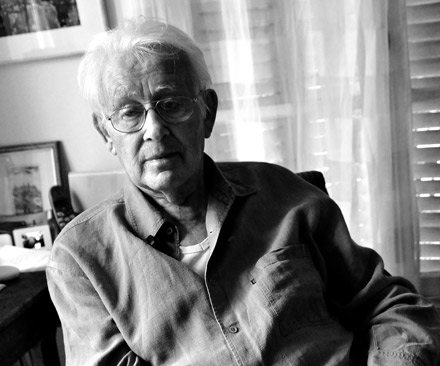
Georges Charpak in 2008. Photo: M. Struik
All of CERN was deeply saddened to learn the news that our friend and colleague, Georges Charpak, passed away on 29 September 2010.
More information
- Message from the Director General
- CERN website: 1968: Georges Charpak revolutionizes detection
- Video: Interview with Charpak at 85
- CERN Courier: Georges Charpak: hardwired for science
- La main à la pâte, the association Charpak founded to improve science education.
28.09.10: LHC particle beams running like trains
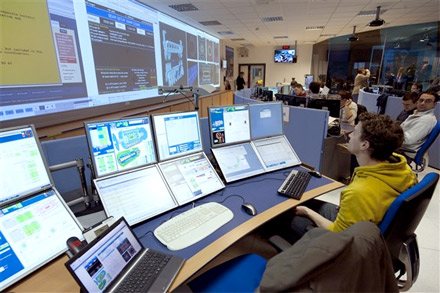
Inside the control room of the ATLAS experiment. Physicists monitor and control the ATLAS detector that lies in a cavern 100m below ground, gathering data on particle colllisions. More photos »
The Large Hadron Collider has been steadily increasing the number of collisions that it delivers to the experiments.
The beams of particles that the LHC accelerates in opposite directions before bringing them into collision are made up of small 'bunches' of protons. Over a hundred proton bunches are now being made to circulate in tightly-sequenced 'trains' in each beam, greatly increasing the amount of data available to the collaborations that run the LHC experiments.
When the LHC is at full power, it will accelerate up to 2808 bunches of particles per beam, with each bunch containing around 100 billion protons.
More information
21.09.10: LHC experiment observes a potentially new and interesting effect
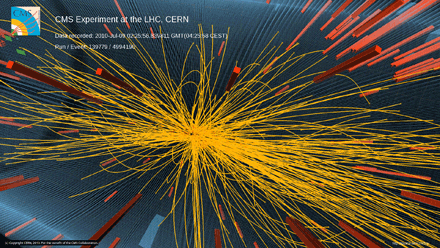
Image of a 7 TeV proton-proton collision in CMS producing more than 100 charged particles. [See full-size version]
After almost six months of operation, experiments at the LHC are starting to see signs of potentially new and interesting effects. In results announced by the CMS collaboration today, correlations have been observed between particles produced in 7 TeV proton-proton collisions.
In some of the LHC’s proton-proton collisions, a hundred or more particles can be produced. The CMS collaboration has studied such collisions by measuring angular correlations between the particles as they fly away from the point of impact, and this has revealed that some of the particles are intimately linked in a way not seen before in proton collisions.
Having re-measured known physics in time for the summer conferences, the LHC experiments are now starting to probe new ground. ATLAS recently extended limits on excited quarks, while the LHCb detector has demonstrated its capacity by observing atom-like particles built from beauty quarks and antiquarks.
More information
20.09.10: Be a researcher for an evening on European researchers’ night, Friday 24 September
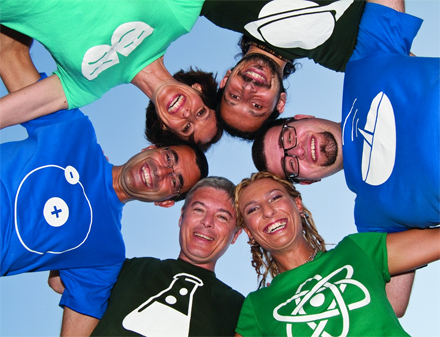
CERN will be one of 260 European locations involved in the 5th edition of the European Researchers’ Night, an initiative funded by the European Union’s Science and Society programme aimed at highlighting the appeal of being a researcher and promoting scientific research among young Europeans.
The main focus of this 5th edition will be international networking, demonstrated through a live webcast – the Globe Show. From 17:00 to 01:00 CET, the Globe Show will come live from CERN’s Globe of Science and Innovation, Frascati’s main square, the JET laboratory and the Erasmus Medical Centre.
More information
26.08.10: The AMS-02 experiment moves to the Kennedy Space Centre. Next stop: the ISS.

The US Air Force C-5 Galaxy carrying the Alpha Magnetic Spectrometer (AMS-02) experiment takes off from the Geneva International Airport on 26 August. More photos.
After an 11 hour-long flight, the US Air Force C-5 Galaxy carrying the Alpha Magnetic Spectrometer (AMS-02) experiment has landed at the Kennedy Space Centre (KSC) in Florida, US. Yesterday, at the Geneva International Airport, the 7.5-ton experiment had been loaded into the aircraft, which is one of the largest in the world.
At the KSC, AMS-02 will undergo a few additional tests in the Space Station Processing Facility of NASA before being launched on board the Space Shuttle Discovery on its final mission to space. Once docked on the International Space Station, the experiment will collect data for more than a decade.
From space, AMS-02 will examine fundamental issues about matter and the origin and structure of the Universe. Its main scientific target is the search for dark matter and antimatter, in a programme that is complementary to that of the Large Hadron Collider.
More information
05.08.10: First African School of Physics gets under way
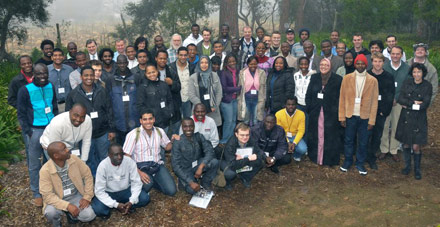
The African School of Physics is supported by a number of research institutions around the world, including CERN. It brings together 59 students with leading experts in high energy physics.
Young physicists are gathering in Stellenbosch in South Africa for the first African School of Physics.
“Physics at CERN is a global venture, but not many African scientists are involved,” explains Christine Darve, organizer of the school and an accelerator engineer from Fermilab. Currently, there are 51 researchers from Africa at CERN, 18 of whom are from African institutes. “Sub-Saharan African countries are under-represented in CERN’s collaborations”, confirms John Ellis, CERN’s advisor for non-Member States. “Among other objectives, this new type of school will help to consolidate existing and emerging collaborations, and may start new ones”.
The school programme focusses on three main topics: theoretical subatomic physics, experimental subatomic physics, and accelerators and technology.
More information
29.07.10: The proton as seen by the TOTEM experiment
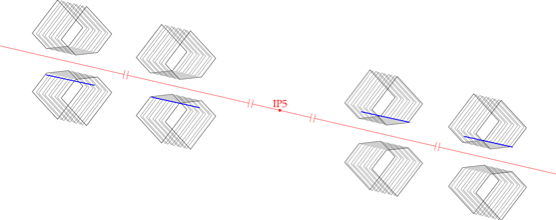
Two protons have collided head-on in the LHC and scattered like two billiard balls, leaving tracks (shown in blue) in some of TOTEM's detectors (grey) located 220m from the interaction point (IP5).
TOTEM, one of the smaller experiments at the LHC, has recently recorded the first signals of proton-proton elastic scattering at a collision energy of 7 TeV. It is the first time that such data has been made available to researchers at such high energy. Studying the elastic scattering between two protons is a powerful way of exploring the inner structure of the proton, one of the most common, yet still poorly understood, particles we observe in Nature.
More information
22.07.10: Particle physicists gather in Paris to hear latest news from CERN and other labs

Over a thousand physicists are gathering at the International Conference on High Energy Physics (ICHEP 2010) in Paris to discuss their latest results.
The spokespersons of the four major experiments at the LHC – ALICE, ATLAS, CMS and LHCb – will on Monday present measurements from the first three months of successful LHC operation at 3.5 TeV per beam, an energy three and a half times higher than previously achieved at a particle accelerator.
More information
07.07.10: LHC delivering ever more collisions to the experiments
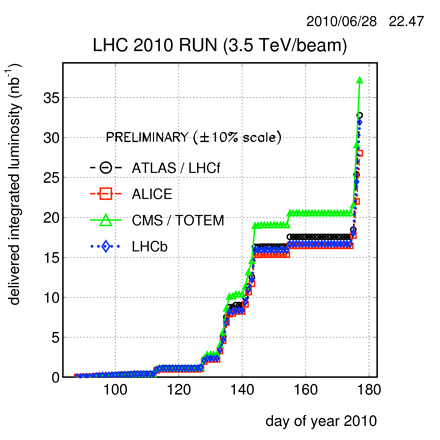
Chart showing the rise in integrated luminosity of the LHC beams between March and the end of June 2010.
After a short break in order to carry out machine development, the LHC began delivering collisions with more protons per bunch and several bunches per beam, thereby dramatically increasing the number of collisions per second. The integrated luminosity delivered to the experiments - a measure of the number of collisions - rose to 32 inverse nanobarns at the end of June, double the luminosity at the beginning of high-energy collisions on 30 March.
Higher luminosity means more collisions, and consequently more precious data for physicists. The Worldwide LHC Computing Grid (WLCG), which distributes LHC data to physicists all over the world for analysis, has seen a rise in average data throughput over the past month from around 420MB per second to over 820MB per second.